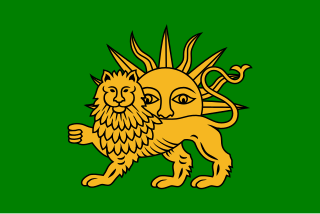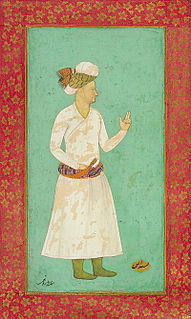
The Safavid dynasty was one of the most significant ruling dynasties of Iran from 1501 to 1736. The Safavid dynasty had its origin in the Safavid order of Sufism, which was established in the city of Ardabil in the Iranian Azerbaijan region. It was an Iranian dynasty of Kurdish origin, but during their rule they intermarried with Turkoman, Georgian, Circassian, and Pontic Greek dignitaries. From their base in Ardabil, the Safavids established control over parts of Greater Iran and reasserted the Iranian identity of the region, thus becoming the first native dynasty since the Sasanian Empire to establish a national state officially known as Iran.

Tahmasp I was an influential Shah of Iran, who enjoyed the longest reign of any member of the Safavid dynasty. He was the son and successor of Ismail I.
The Safavid order, also called the Safaviyya, was a tariqa founded by the Kurdish mystic Safi-ad-din Ardabili (1252–1334). It held a prominent place in the society and politics of northwestern Iran in the fourteenth and fifteenth centuries, but today it is best known for having given rise to the Safavid dynasty. While initially founded under the Shafi'i school of Sunni Islam, later adoptions of Shi'i concepts such as the notion of the Imamate by the children and grandchildren of Safi-ad-din Ardabili resulted in the order ultimately becoming associated with Twelverism.

The Battle of Chaldiran took place on 23 August 1514 and ended with a decisive victory for the Ottoman Empire over the Safavid Empire. As a result, the Ottomans annexed Eastern Anatolia and northern Iraq from Safavid Iran. It marked the first Ottoman expansion into Eastern Anatolia, and the halt of the Safavid expansion to the west. The Chaldiran battle was just the beginning of 41 years of destructive war, which only ended in 1555 with the Treaty of Amasya. Though Mesopotamia and Eastern Anatolia were eventually reconquered by the Safavids under the reign of Shah Abbas the Great, they would be permanently lost to the Ottomans by the 1639 Treaty of Zuhab.
Qizilbash or Kizilbash, were a wide variety of mainly Turkoman Shia militant groups that flourished in Iranian Azerbaijan, Anatolia and Kurdistan from the late 15th century onwards, and contributed to the foundation of the Safavid dynasty of Iran.

The Isfahan School is a school of Islamic philosophy. It was founded by Mir Damad and reached its fullest development in the work of Mulla Sadra. The name was coined by Seyyed Hossein Nasr and Henry Corbin.

The history of Ottoman–Safavid relations started with the establishment of Safavid dynasty in Persia (Iran) in the early 16th century. The initial Ottoman–Safavid conflict culminated in the Battle of Chaldiran in 1514, and was followed by a century of border confrontation. In 1639, Safavid Persia and Ottoman Empire signed the Treaty of Zuhab which recognized Iraq in Ottoman control, and decisively parted the Caucasus in two between the two empires. For most of it, the Zuhab treaty was a consolidation of the Peace of Amasya of about a century earlier.

The Peace of Amasya was a treaty agreed to on May 29, 1555 between Shah Tahmasp of Safavid Iran and Sultan Suleiman the Magnificent of the Ottoman Empire at the city of Amasya, following the Ottoman–Safavid War of 1532–1555.
Religion in Iran has been shaped by multiple religions and sects over the course of the country's history. Zoroastrianism was the main religion during the Achaemenid Empire, the Parthian Empire and the Sasanian Empire. In 651 AD, the Rashidun Caliphate conquered Persia and spread Islam as the main religion. Sunnism was the predominant form of Islam before the devastating Mongol conquest, but subsequently, Shi'ism became eventually utterly dominant in all of Iran with the advent of the Safavids.
The Safavid conversion of Iran to Shia Islam was a process that took place roughly over the 16th through 18th centuries and turned Iran (Persia), which previously had a Sunni majority, into the spiritual bastion of Shia Islam. It was a process that involved forced conversion and resulted in hostility with Iran's Sunni neighbours, particularly the Ottoman Empire. The conversion also ensured the dominance of the Twelver sect within Shiism over the Zaidiyyah and sects of Isma'ilism – each of whom had previously experienced their own eras of dominance within Shiism. Through their actions, the Safavids reunified Iran as an independent state in 1501 and established Twelver Shiism as the official religion of their empire, marking one of the most important turning points in the history of Islam.

The Kar-Kiya dynasty, also known as the Kiya'ids, was a Zaydi Shia dynasty which ruled over Biya-pish from the 1370s to 1592. They claimed Sasanian ancestry as well. Lahijan was the dynasty's capital.

Mirza Mohammad Taqi, better known as Saru Taqi was a eunuch of Safavid Empire, who served as the Grand Vizier of the Safavid king (shah) Safi and the latter's son Abbas II until he was assassinated on 11 October 1645.
Lebanese people in Iran refers to Lebanese living in Iran or Iranians of Lebanese descent. The Lebanese populate various regions and cities, but historically the religious city of Qom has been a principal area of settlement.
The Sack of Shamakhi took place on 18 August 1721, when rebellious Sunni Lezgins, within the declining Safavid Empire, attacked the capital of Shirvan province, Shamakhi. The initially successful counter-campaign was abandoned by the central government at a critical moment and with the threat then left unchecked, Shamakhi was taken by 15,000 Lezgin tribesmen, its Shia population massacred, and the city ransacked.

Selim I , known as Selim the Grim or Selim the Resolute, was the Sultan of the Ottoman Empire from 1512 to 1520. Despite lasting only eight years, his reign is notable for the enormous expansion of the Empire, particularly his conquest between 1516 and 1517 of the entire Mamluk Sultanate of Egypt, which included all of the Levant, Hejaz, Tihamah, and Egypt itself. On the eve of his death in 1520, the Ottoman Empire spanned about 576,900 sq mi (1,494,000 km2), having grown by seventy percent during Selim's reign.
Khwaja Afzal al-Din Fazl Allah b. Jamal al-Din Ruzbihan b. Fazl Allah b. Muhammad Khunji Isfahani, better known as Fazlallah Khunji Isfahani, was a Persian religious scholar, historian and political writer. He was born in Shiraz. In 1487, he left Shiraz for the third time for a Hajj. He met Sultan Ya'qub of Aq Qoyunlu near the Sahand mountain and agreed to write the history of Aq Qoyunlu dynasty. When the Safavid shah Ismail I started the Shi'ification of Persia and the persecution of Sunni Muslims, he fled to Transoxiana and settled in the city of Kazan. He lived the rest of his life in Transoxiana under the patronage of Timurids and Shaybanids. Modern scholars praise him for his neutrality.
The Khalifeh family, also known as the Khalifeh sayyids, were a branch of the Marashi dynasty of Mazandaran, whose ancestor, Amir Nezam al-Din, had settled in the Golbar quarter of Isfahan in the 15th-century.
Mirza Mohammad Mahdi Karaki was an Iranian cleric and statesman, who served as the grand Vizier of the Safavid king (shah) Abbas II, and the latters son and successor Suleiman I. He was the son of Mirza Habibollah Karaki, who served as the sadr-i mamalik from 1632/3 till his death 1650.
Makhdum Sharifi Shirazi was a Persian Sunni statesman and author, who served as the minister of religious affairs (sadr) during the reign of Ismail II, and ultimately took refuge in the Ottoman Empire, where he wrote the al-Nawaqez le-bonyān al-rawafez, a sizable anti-Shia argumentative book.
Iase Tushi was a Georgian writer who worked and lived in the Safavid Empire. He is known for his polemical poem Sametsniero, an illuminated work distinguished by one of the earliest examples of a Georgian–Persian dictionary, and is "the earliest Georgian manuscript so far discovered in Iran".









